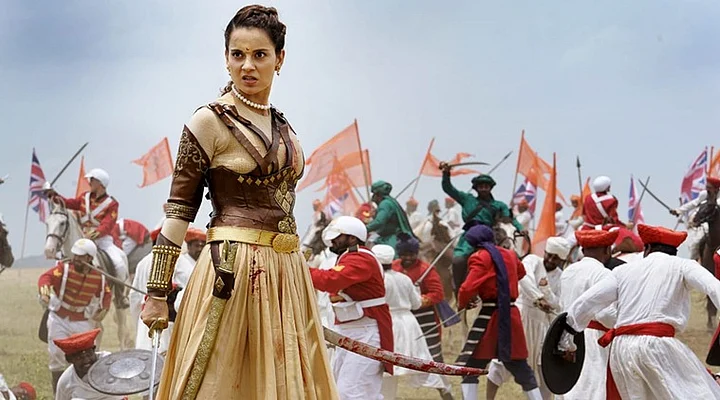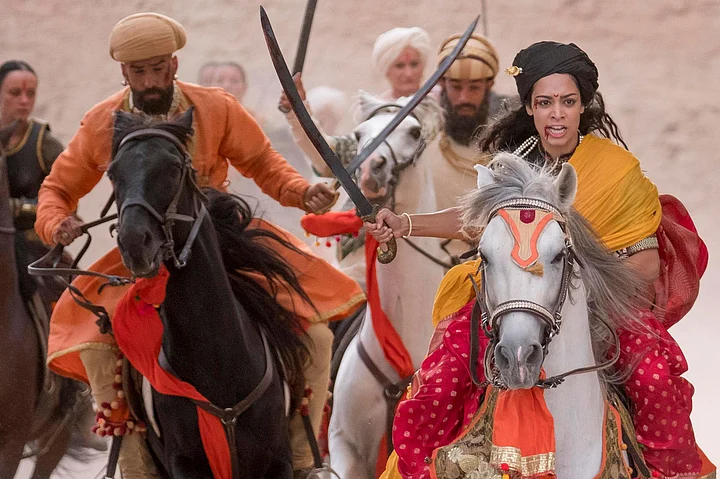‘Queen Lakshmibai is one smart woman. Look what she writes,’ laughs Lord Dalhousie on receiving a missive from the Queen of Jhansi in The Queen’s Last Salute. ‘Can you believe it? She says, ‘Helpless and prostrate, I once more entreat Your Lordship to grant me a hearing’…,’ Dalhousie read out her words aloud. ‘Helpless and prostrate? Maharani Lakshmibai? Now that her arguments hold no steam with me, she is using the tool of the helpless widow!’ On the same queen’s death, Sir Hugh Rose, who fought in the battle in which Rani Lakshmibai was killed wrote that she was the most dangerous of all Indian leaders - “A man among mutineers”.
Well, that’s Maharani Lakshmibai for you. Ready to spring or stoop as the situation demands. And, that’s precisely the reason why we love her and we can’t stop making her the subject of books and films. It is not surprising that the life of a 25-year-old widowed queen who challenged the powerful British, would continue to interest and intrigue writers and filmmakers spanning generations and of whom there have been many.
Charting the Literary Representations
- The known, unknown, the conventional and the unconventional
Most novels such as Manu, and Queen of Glory by Christopher Nicole and the Rebel Queen: A Novel by Michelle Moran focus upon Maharani Lakshmi Bai's life, her reign and her subsequent martyrdom, reinforcing the image of the young widowed queen of Jhansi as most Indians would like to see her – the archetype of a celibate, virtuous widow. However, a few writers have dared to deviate and have instead drawn up an unlikely portrayal of the legendary queen. Of these, Jaishree Misra’s Rani lends an interesting twist, albeit a little improbable one, to the queen’s life by weaving in a love affair between the queen and Robert Ellis, the British political agent stationed in Jhansi at the time.
What is surprising is that it is an Indian writer who chooses to depict the much-revered queen as a woman who is capable of succumbing to an emotional weakness, thus somewhat diminishing the halo surrounding her.
There are other novels too along the same lines in which Lakshmibai has either been romantically linked with other men such as in ‘La Femme Sacree’, a French novel by Michel de Grece, or may have been shown in an unfavourable manner in books such as ‘The Rane: A Legend of the Indian Mutiny’ written by Gillean, a British military officer in 1887.
‘The Queen's Desire’ by Hume Nisbet published in 1893 focuses on the Rani's sexuality and her inability to resist a British officer she falls in love with.
These titles could have been objectionable to most Indians since Rani Lakshmibai is held in high esteem and is the embodiment of all that is heroic and virtuous. Any suggestion to the contrary, or any hint of a sexual, erotic or romantic liaison of Rani Lakshmibai with a man would be instantly rejected and vehemently opposed. But, since the above are mostly written by foreigners or by the British, they can be summarily dismissed, and the writers forgiven.
Making Her Mark on the Silver Screen
Besides these books, there is very little representation of Rani Lakshmibai in contemporary, popular culture. Barring a couple of television serials, there was Sohrab Modi’s 1953 historical hindi movie, Jhansi Ki Rani, the only feature film based on the life of the Queen of Jhansi.
The first technicolour film to be made in India, it featured Modi’s wife Mehtab as Lakshmibai and had the Hollywood Oscar-winning cinematographer Earnest Hailer and other Hollywood technicians work on it.
The film, which was based on Vrindavan Lal Verma’s 1946 novel ‘Jhansi ki Rani’, was later dubbed in English and released with the title ‘The Tiger and the Flame’, in 1956.
Besides these few examples, Maharani Lakshmibai has been featured in Ketan Mehta’s The Rebel, a companion piece to his Mangal Pandey: the Rising, and in the upcoming 2019 Hollywood film, Swords and Sceptres, featuring Devika Bhise as Rani Lakshmibai. Maharani Lakshmibai is also the pivotal character in the Hindi film Manikarnika, starring Kangana Ranaut as Maharani Lakshmibai.
- 01/02Kangana Ranaut in Manikarnika.(Photo courtesy: Twitter)

- 02/02Devika Bhise stars as Rani of Jhansi in Swords and Sceptres (2019).(Photo courtesy: Twitter)

While Modi’s Jhansi Ki Rani took the familiar route of portraying the mighty queen of Jhansi as a never-say-die warrior queen who dies in battle, we wonder if the other two upcoming films will stretch the narrative beyond the clichéd portrayal of Rani Lakshmibai or dare to delve further into the multifaceted, powerful and enigmatic character of the young queen and bring alive certain aspects and complexities of her life and personality that until now haven’t been revealed.
That is a side that is yet to be seen.
(Former journalist at The Times of India, the Economic Times, The Indian Express and Business Today, Moupia Basu grew up in the Delhi of the 70s and 80s. Her debut book Khoka, published by the National Book Trust of India, was released in 2015. This is an opinion piece and the views expressed above are the author’s own. The Quint neither endorses nor is responsible for the same.)
(At The Quint, we question everything. Play an active role in shaping our journalism by becoming a member today.)


